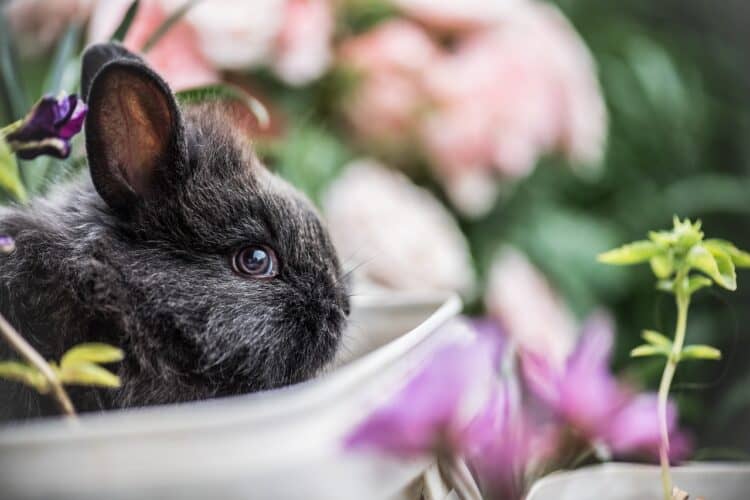Question: Is it safe for a rabbit to stay outside when it’s 88 degrees F?
Hi, we are rabbit-sitting for a friend for 3 weeks. They told us the rabbit recently went through an ear infection and completed a course of antibiotics. He is normally kept in a cage indoors, but my son built a rabbit “fort” for him out of cardboard boxes and it is outside in our enclosed patio.
The high today here is supposed to be 88 degrees and I’m wondering if you think he’d be ok out there or if I should just bring him back indoors and only put him out there morning and evening when it’s cooler. I’m constantly checking his water bowl and I have fans going out in the patio.
The patio is surrounded by sliding glass doors and they are all open with screen doors closed. It just seems like he has much more room to move around out there than in his cage. But I’m just worried about him getting too hot.
–Carolyn
Answer:
Dear Carolyn,
You’re so sweet to help your friend by caring for their rabbit. Sounds like you’re a very conscientious caretaker!
Rabbits can definitely become stressed by extremes in environmental temperatures. Heat is especially hard on them. A rabbit’s wonderfully big ears help regulate their body temperature. That helps some, but in a cage or pen, a rabbit can’t burrow in the ground to keep cool.
Rabbits acclimated to outdoor living can tolerate more heat than those who have lived strictly indoors in air-conditioned comfort. Even rabbits who are used to being outside can become stressed in very hot weather.
Temperatures approaching 80 degrees Fahrenheit may be high enough to cause physical stress. If a rabbit is in direct sun with no option for shade, the effect will be even worse.
It’s safer to keep a rabbit in the house during the hottest part of the day. You’ll want to make sure he is securely contained on your patio, too. Rabbits can chew their way through screens in no time!
Many rabbit owners use folding playpens to keep their bunnies safely confined indoors. A pen allows them much more space to move around.
Don’t leave him outdoors or on the patio unsupervised in case he tries to escape or another animal tries to break in to attack him. I’m concerned about the security of the screen doors. You’d be surprised what wild animals and dogs will do to gain access to a rabbit.
Tips to Keep Your Rabbit Cool
For folks who don’t have the option of bringing their rabbit inside, or if you don’t have air conditioning, here are some tips to keep your bunny cool:
- Keep the rabbit cage or pen in a shady area. If you can’t move it, place tarps or sheets over the pen to create a shady oasis.
- Use fans pointed toward the cage to help with evaporative cooling. These pet fans are great options.
- Freeze water in plastic bottles to place in the cage. Many rabbits will lie next to the ice to stay cool.
- Offer a large ceramic tile for the bunny to sit or lie on. The tile will help draw heat away from his body.
- Put ice cubes in his water dish or bottle. You’ll want to do this a few times during the hot part of the day.
- If you live in a dry environment, an evaporative cooling system or swamp cooler placed near the rabbit pen can work almost as well as air conditioning. If you live where it’s humid, this option won’t be helpful.
- You can also get a cooling mat for your bunny and place it inside their cage. Cooling mats can keep your bunny cool and comfortable for 4 hours or more.
Readers who keep their bunny outdoors in a cage: please consider bringing him inside to live with the family! Rabbits are intelligent and fun animals who can make great indoor pets. They’re quiet, make great cuddling companions, and can be litter box trained.
House rabbits tend to receive better care because they’re under closer observation. The lifespan of an indoor rabbit is much longer and their quality of life is better than rabbits kept in an outdoor cage. Rabbits can spend some time outdoors with supervision during cooler weather, but it’s a rough life for a bunny to be outdoors in a cage day after day.
The House Rabbit Society offers many free educational resources on how to care for rabbits indoors. You might even consider adopting a rabbit in need of a home from your local rabbit rescue group.
Regards,
TB Thompson DVM
Disclaimer: Your use of the Ask The Vet feature is subject to the Ask The Vet Terms of Use.
Featured Image Credit: Pixabay




















